Achilles Tendinopathy – 4 Exercises Towards Recovery
Overview
When the Legendary Achilles was born, his mother, the goddess Thetis, tried to make him immortal by dipping him in the river Styx. However, she held him by the heel and it was left vulnerable, becoming his weak spot.
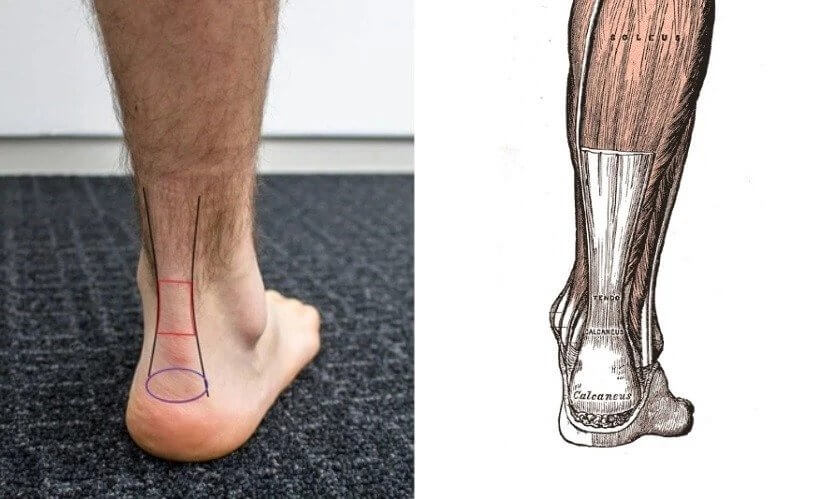
Many people have this same weak spot, more specifically the Achilles Tendon (Figure 1), which can be quite debilitating when you want to get the kids ready in the morning and rush to work, to run or practise any sport for which you need to stand, run or jump, etc.
What is a tendon or a tendinopathy?
Tendons work like ropes, so when a muscle contracts it pulls the tendon that pulls the bone where it is attached, moving the joint. So tendons don’t contract or shrink, but they have to be experts in dealing with the load put upon them. Like any soft tissue, tendons have the ability to adapt to load, therefore, as we gradually increase the load in the tendon, the tendon will change and become stronger (but it also works the other way around). The problem here is when the increase in load is not GRADUAL, but SUDDEN. Then, the load put through the tendon is greater than its capacity to take it and it may not cope leading to changes in its structure and weakening of its architecture. This is change is not normal and will gradually affect the ability of the tendon to bear load that we consider normal and it’s what we call a Tendinopathy.
What are the symptoms?
- Morning stiffness, especially the first steps due to the change from “no load” in bed to first moments of “weight bearing”;
- Tenderness over the tendon, very tender to touch even when you squeeze it gently;
- Variable pain, some people can exercises through pain which seems to help it gradually, but some people won’t be able to exercise or walk due to severe pain.
What causes tendinopathy? what are its risk factors?
In order to work on this condition it’s important to understand what main factor has led to it in the first place to identify the mechanism of overload, so that we can act directly on the cause. There are several of these factors:
- New shoes or very worn shoes;
- Abrupt change in running pace;
- Abrupt increase in the amount of walking/running;
- Reduced rest periods;
- Increase in uphill running;
- Changes in the gym routine;
- Trauma to the lower limb including its joints: hip, knee or ankle;
- Other imbalances up the leg;
- Pain on the other foot, etc.
After we identified the most relevant factor(s) and, as we work on it, we, then, need to give the tendon a good program of tendon loading. Evidence suggests Eccentric Load Exercises are the best to achieve this outcome. Eccentric means we load the muscle+tendon as they lengthen. I know it may be confusing, but don’t worry, you’ll be able to due it, regardless!
Exercises for Achilles Tendinopathy
Below, we show you 2 Stretching Exercises and 2 Eccentric Exercises, that should be done feeling no more than a discomfort, but NO PAIN.
Exercise 1: Gastrocnemius Stretch
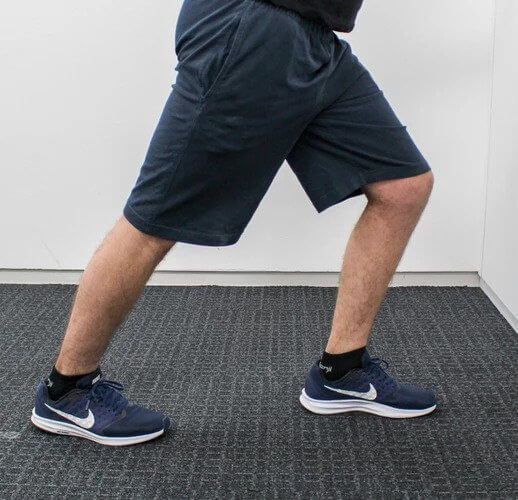
How to do it
- Facing a wall, put your hands on the wall.
- Stand with BAD leg back and knee straight. The GOOD leg forward and bent.
- Keeping the BAD heel on the floor and the knee straight, lean towards the wall, bending the good knee further, until stretch is felt in the calf of the BAD leg.
Exercise 2: Soleus Stretch
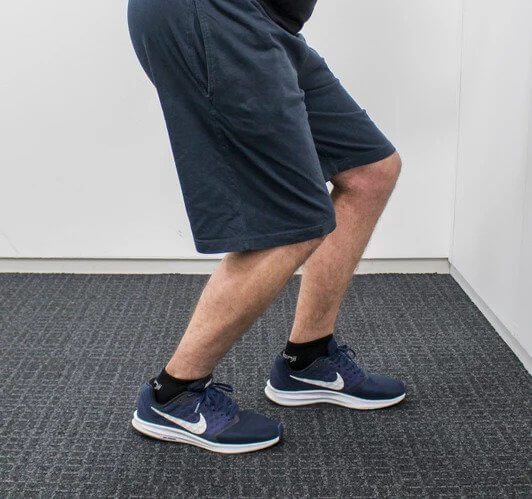
How to do it
- Facing a wall, put your hands on the wall.
- Stand with BAD leg back, both knees bent.
- Keeping both heels on the floor, bring your buttocks down, bending both knees, stretch is felt in the lower calf of the BAD leg.
- Hold for 20-30 secs.
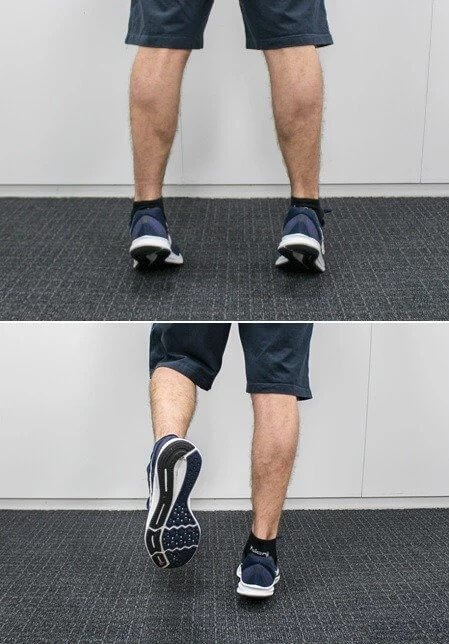
Exercise 3: Gastrocnemius Eccentric Exercise
How to do it
- Stand on both feet.
- Use the both legs to raise up onto tiptoes.
- Transfer your weight across to your bad leg, lift the good leg off the floor and slowly lower yourself down.
- Repeat.
- 3x 15 repetitions, TWICE a day
Exercise 4: Soleus Eccentric Exercise
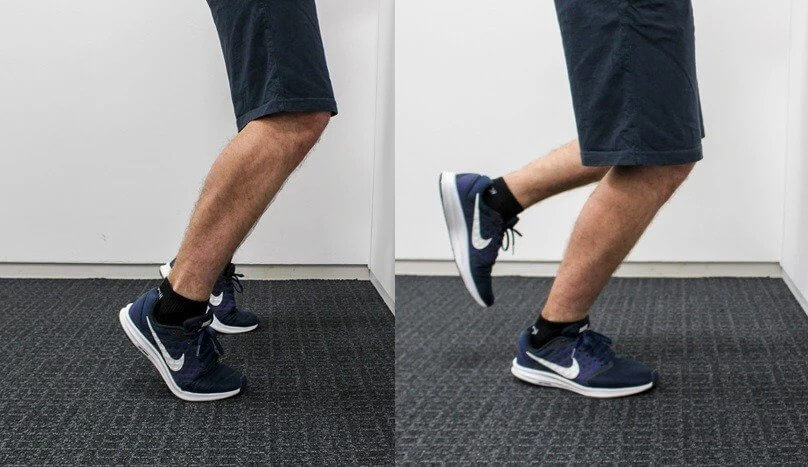
How to do it
(Same as per Exercise 3, but with the knees always bent)- Stand on both feet.
- Keeping your knees bent, use the GOOD or both legs to raise up onto tiptoes.
- Transfer your weight across to your BAD leg and SLOWLY lower yourself down.
- Repeat.
- 3x 15 repetitions, TWICE a day
Try these exercises and let us know how you’ve felt!
*****Disclaimer: When attempting these exercises, please use common sense and do not perform or modify if there is pain or discomfort! Irritated achilles tendons can be sensitive areas so please look for a qualified physiotherapist if you do experience significant pain. They can treat and supervise you through these exercises.
References:
- Alfredson H, Pietila T, Jonsson P, Lorentzon R (1998) Heavy-load eccentric calf-muscle training for the treatment of chronic Achilles tendinosis. Am J Sports Med 26:360–366
- Young MA, JL Cook, CR Purdam, ZS Kiss, and H Alfredson. (2005) Eccentric decline squat protocol offers superior results at 12 months compared with traditional eccentric protocol for patellar tendinopathy in volleyball players. Br J Sports Med.; 39: 102-105.
- van der Plas a., de Jonge S, de Vos RJ, et al (2012). A 5-year follow-up study of Alfredson’s heel-drop exercise programme in chronic midportion Achilles. Br J Sports Med.;46(3):214-218
- Kerr, J. (2005), Achilles tendon injury: assessment and management in the emergency department, Emergency Nurse: 2005 May;13(2):32-8
- Gray’s Anatomy (2008), The Anatomical Basis of Clinical Practice (40th ed.), Churchill-Livingstone, Elsevier, ISBN 978-0-443-06684-9
